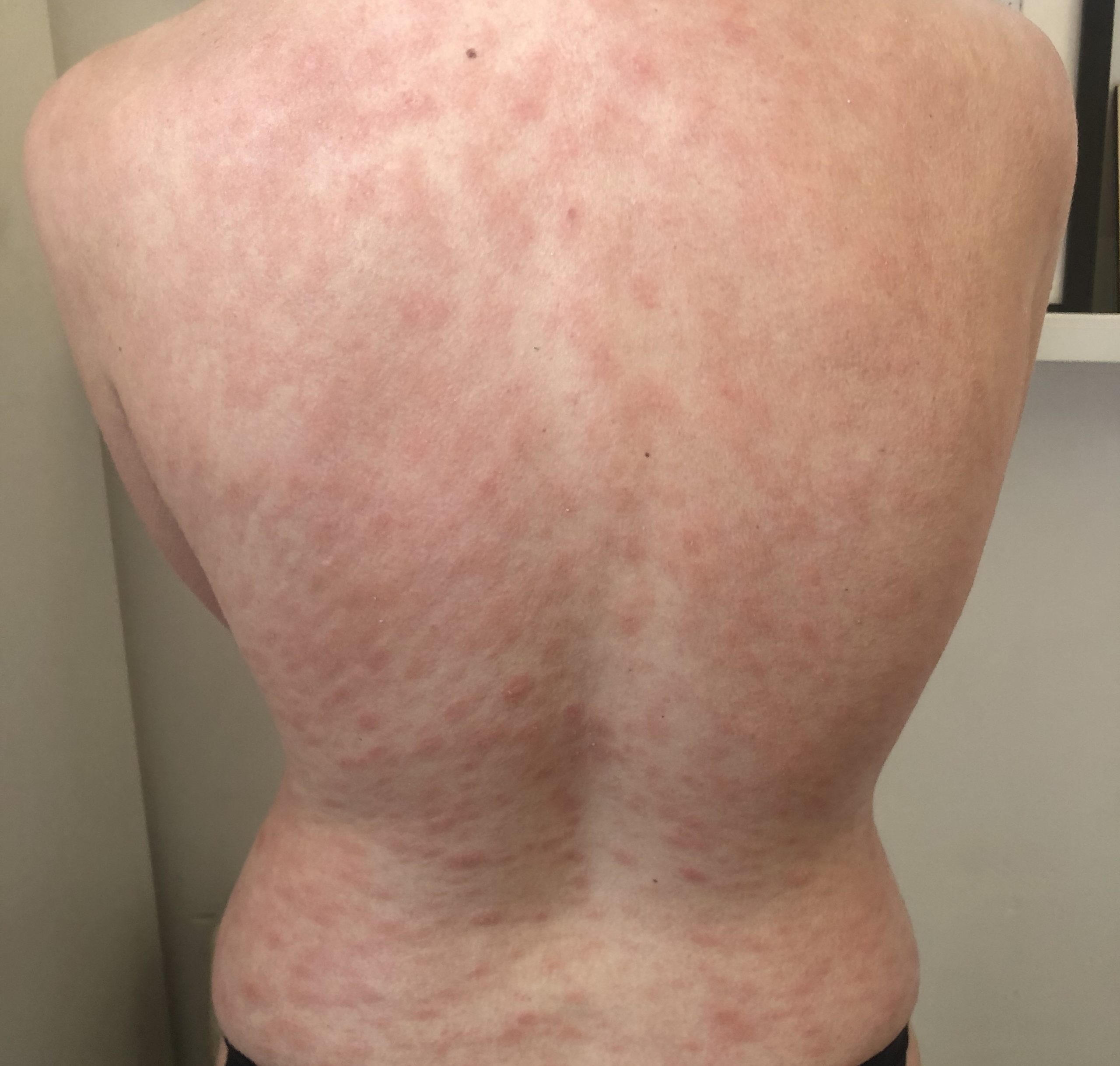What are the symptoms of a viral exanthem rash?
The symptoms of a viral exanthem rash, which is a rash caused by a viral infection, can vary depending on the specific virus involved, but commonly include:
- Red or Pink Rash: The rash often appears as red or pink spots or patches on the skin. It can spread quickly across the body.
- Macules and Papules: The rash may start as small, flat spots (macules) that can develop into raised bumps (papules).
- Pattern and Distribution: The rash often follows a specific pattern and may begin on the face or trunk before spreading to other parts of the body. The distribution can help in diagnosing the specific viral infection.
- Fever: Many viral exanthems are accompanied by a fever, which may precede the rash.
- Itching or Discomfort: The rash can be itchy or uncomfortable, though the level of discomfort varies.
- Systemic Symptoms: In addition to the rash, other symptoms such as sore throat, cough, runny nose, or body aches may be present, depending on the underlying viral infection.
- Progression: The rash may change over time, evolving from red spots to more generalized or even blotchy areas before fading. It often goes through stages, such as spots merging together or peeling.
Common viral exanthems include measles, rubella, roseola, and chickenpox, each with distinct rash characteristics and accompanying symptoms. For a definitive diagnosis and appropriate management, consulting a healthcare provider is essential.
What are the causes of a viral exanthem rash?
A viral exanthem rash is caused by various viral infections. The causes include:
- Measles (Rubeola): Characterized by a red, blotchy rash that often starts on the face and spreads downwards, accompanied by high fever, cough, runny nose, and Koplik spots inside the mouth.
- Rubella (German Measles): Presents with a pink or light red rash that starts on the face and spreads, often with mild fever and swollen lymph nodes.
- Roseola (Sixth Disease): Caused by human herpesvirus 6 (HHV-6) or less commonly HHV-7, it begins with a high fever followed by a pink or red rash that starts on the trunk and spreads to the limbs.
- Chickenpox (Varicella): Characterized by an itchy rash that starts as red spots and progresses to fluid-filled blisters and scabs, often accompanied by fever and malaise.
- Fifth Disease (Erythema Infectiosum): Caused by parvovirus B19, it typically starts with a “slapped cheek” appearance and then develops into a lacy, reticular rash on the body.
- Coxsackievirus (Hand, Foot, and Mouth Disease): Results in a rash with red spots and sometimes sores on the hands, feet, and mouth, often accompanied by a mild fever.
- Enterovirus Infections: These can cause a variety of rashes, including those associated with diseases like hand, foot, and mouth disease and viral exanthems.
- Herpes Simplex Virus (HSV): Can cause a rash, especially in newborns or in cases of eczema herpeticum, which presents as clusters of vesicles on an inflamed base.
- HIV: In the early stages, HIV can cause a rash that may be a sign of acute retroviral syndrome.
These viral exanthems typically follow specific patterns and stages, which help in distinguishing them from other causes of rashes.
What is the treatment for a viral exanthem rash?
The treatment for a viral exanthem rash primarily focuses on managing symptoms and providing supportive care, as the rash itself usually resolves as the underlying viral infection runs its course. Specific treatments include:
- Antipyretics and Analgesics: Medications like acetaminophen or ibuprofen can help reduce fever and relieve discomfort associated with the rash.
- Hydration: Ensuring adequate fluid intake helps prevent dehydration, especially if the patient has a high fever.
- Topical Treatments: For rashes that cause itching or discomfort, topical antihistamines or corticosteroids may be used to alleviate symptoms. Calamine lotion and oatmeal baths can also soothe itching.
- Good Skin Care: Keeping the skin clean and dry can help prevent secondary bacterial infections. Avoid scratching the rash to reduce the risk of infection.
- Rest: Adequate rest supports the immune system in fighting the viral infection.
- Antiviral Medications: In some cases, antiviral medications may be prescribed if the rash is due to specific viral infections such as chickenpox or herpes simplex, particularly if treatment is started early.
- Isolation: For certain viral exanthems, like measles or chickenpox, it may be necessary to isolate the patient to prevent the spread of the infection to others.
The treatment approach may vary depending on the specific viral infection causing the rash, and it’s important to consult a healthcare provider for an accurate diagnosis and appropriate treatment plan.

Leave a Reply
You must be logged in to post a comment.